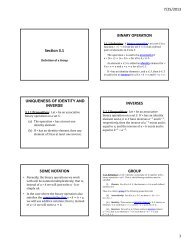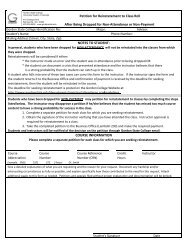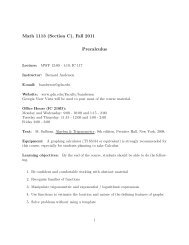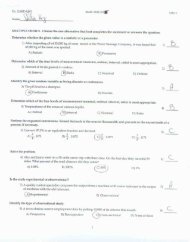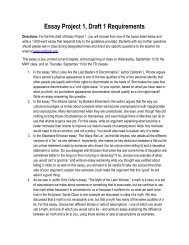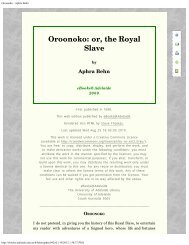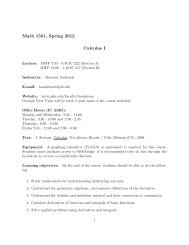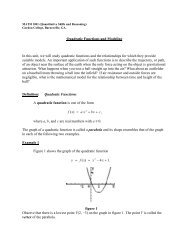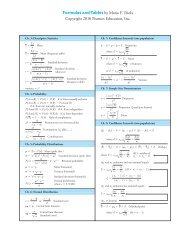President's Report - Gordon State College
President's Report - Gordon State College
President's Report - Gordon State College
You also want an ePaper? Increase the reach of your titles
YUMPU automatically turns print PDFs into web optimized ePapers that Google loves.
21<br />
President’s <strong>Report</strong><br />
Going in as corporals was better than going in as raw recruits,<br />
but at the time there were few corporals in the Army. That rank<br />
was replaced by something called a specialist 4. While at Ft. Jackson,<br />
the three of them started carrying their orders in their pockets,<br />
because they were always being stopped by sergeants who didn’t<br />
believe the Army had any more corporals.<br />
Then they reaped another benefit from their time at <strong>Gordon</strong>.<br />
When they finished their basic and advanced training at Ft. Jackson,<br />
they were allowed to go into officer candidate school (OCS)<br />
without the Army’s enrollment quota applied to them. After six<br />
months, they were second lieutenants at Ft. Benning, eager for<br />
flight school, but because of a “color deficiency” in his eyesight,<br />
Eddy went into jump school.<br />
“After jump school, I went back to Ft. Jackson and hated it,”<br />
he said. “I was an executive officer for a headquarters company,<br />
and all I did was inspect. I hated the job so much I volunteered<br />
for Korea and was sent to Munsan-ne, near the Imjin River and<br />
Panmunjom” – that is, close to the North Korean army along the<br />
demilitarized zone (DMZ) that separates the two Koreas. Or, as<br />
Eddy put it, “along the main thoroughfare to Seoul,” the capital<br />
of South Korea.<br />
At Munsan-ne, Eddy landed the best possible position a<br />
first lieutenant could hope for in an infantry battalion, the job<br />
of reconnaissance platoon leader. Under his command, he had<br />
five jeeps, two personnel carriers and two tanks, which he used to<br />
patrol the area south of the nearby DMZ.<br />
When his tour was over, he returned to Ft. Benning to become<br />
a tactical officer in OCS, where a friend of his told him he<br />
thought the two of them should join the Army’s Special Forces.<br />
“Why” Eddy asked. “Because it sounds intriguing,” his friend<br />
said, and that was that.<br />
“We had instructors who had been in Special Forces for a<br />
long time, and they put us through the grinder,” Eddy said. “The<br />
Special Forces Q Course was probably the best training I ever got,<br />
because it taught us to think as individuals, that no one would be<br />
looking over our shoulders, that we had a mission, and that we<br />
always brought our people back.”<br />
He thought the Congo might be his first mission, because<br />
he was sent to school in D.C. to learn the Lingala language,<br />
but by the time the instruction was finished, they were told<br />
to report to Ft. Bragg where they learned the Congo mission<br />
was canceled and a new one added – Cuba. Off he went with<br />
others to Opa-locka airport north of Miami and waited in<br />
the sun and the humidity and the heat. At night they slept<br />
under the wings of the C-46s that were to carry them to their<br />
drop zone.<br />
“Then we heard about the Bay of Pigs,” he said. And so this<br />
mission was also canceled, and he returned to Ft. Bragg to be assigned<br />
a new mission…, Vietnam.<br />
Cadet Lt. John Eddy (kneeling left) was the commander of Academic Hall.<br />
His training at Eglin Air Force Base, in part, was to be dropped by<br />
parachute early in the morning into an area where he and others<br />
were met by trainers who gave them a map and told to be “at point<br />
A in 24 hours.”<br />
Here, Eddy chuckled quietly and said, “There were two ways<br />
to get to point A. One way was through the swamp and the other<br />
… was through the swamp. For three weeks we stayed wet, but it<br />
was a good time, because it allowed us to evaluate who we would<br />
choose to be on our teams. It was our choice, as officers, of who to<br />
take, so we looked the men over closely.”<br />
With his handpicked team of Green Berets, Eddy was sent<br />
to the little village of Nam Dong, from where he and his team<br />
took long, two- to three-week “walks in the woods” and where he<br />
started a farm.<br />
Started a farm In a village just 15 miles from the Laotian<br />
border where Vietcong and North Vietnamese soldiers traveled<br />
outside the reach of American forces A farm<br />
Well, that’s why they were called Special Forces. The Green<br />
Berets did things a little bit different from the other soldiers. They<br />
went into areas to help the Vietnamese help themselves to not<br />
only combat enemy forces but to have better lives. The idea of the<br />
Special Forces is that it was a counter insurgency force with roots<br />
that go back to Americans being dropped into occupied areas of<br />
Europe to help the resistance fight the Nazis.<br />
For the Special Forces, a village was a personal matter, where<br />
Americans lived with the Vietnamese, certainly to train them to<br />
fight the Vietcong and North Vietnamese, but also to improve<br />
their lives. As evidence of this personal relationship between the<br />
Green Berets and the villagers, to this day Eddy remembers Nam<br />
Dong as “my little village.”<br />
In addition to his Vietnamese forces, Eddy had a few Nung<br />
Chinese, an ethnic minority in Vietnam, who may have been paid



